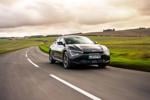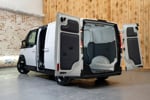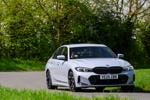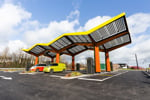Review
Since its launch seven years ago the Audi A3 has built a reputation for quality and refinement in the compact premium market segment. But it doesn't take too long for rivals to catch up so June sees the arrival of the new A3, with a new look and engine range.
At launch, the car comes with what the manufacturer describes as a 'cost-effective' 2.0-litre FSI direct fuel injection petrol unit. Other units include a 1.6-litre petrol and a 2.0-litre TDI. A 1.9-litre TDI with 105bhp and a potent 3.2-litre V6 petrol with 241bhp will follow afterwards.
All engines comply with Euro IV emissions standards, including the new 16-valve 2.0-litre TDI diesel, which means company car drivers can avoid the three percentage point penalty for benefit-in-kind (BIK) taxation on diesel cars which are not Euro IV compliant.
In terms of carbon dioxide emissions, taking the 2.0 TDI A3 as an example, it performs better than its rivals, emitting 149g/km of CO2, compared to 152g/km for the BMW 320td Compact, 155g/km for the Alfa Romeo 147 1.9 JTD and 164g/km for the Mercedes-Benz C220 CDI Sports Coupe. This gives the A3 2.0 TDI a key advantage in BIK tax.
Thanks to being Euro IV compliant, the A3 driver will be taxed at 15% of P11d price in 2003/04 (the lowest band possible) while its rivals will be taxed at 18% (19% for the Mercedes-Benz).
Depending on which engine you choose, it will be fitted as standard with either a five or six-speed manual gearbox, with the new six-speed version of the Tiptronic automatic transmission available as an option, along with the Direct Shift Gearbox (DSG) option already found in the TT V6 coupe.
With the new car you get more interior space as the bodyshell is 30mm wider than its predecessor and its wheelbase has been extended by 65mm.
Rear seat passengers will notice the most difference over the old model, with 29mm more knee room, while both rows of seats offer significantly more shoulder room (up by 30mm in the back and 42mm in the front). And thanks to the seats being mounted lower in the car, the new A3 offers virtually the same amount of headroom as in the previous version, despite being less tall.
The ride quality is also improved by the introduction of four-link rear suspension combined with revised McPherson struts. Like other models in the Audi line-up, the top-of-the-range versions are available with quattro four-wheel drive. Audi expects to sell 8,000 new A3s this year, rising to 16,000 in its first full year. Full UK pricing and specification will be announced in the summer.
Audi sees the A3's greatest rivals as the BMW 320td Compact, the Alfa Romeo 147 JTD and the Mercedes-Benz Sport Coupe C220 Cdi.
For companies wanting their drivers to impress clients without being too flash, the sober but still dynamic Audi range, including the A3, is a perfect choice.
The manufacturer also cites low running costs as one of its main fleet attributes – a fact backed up by the A3's bigger brother, the A4, which has won the Best Premium Upper-Medium Car title at the Fleet News Awards for the last two years.
Figures provided by the manufacturer claim a pence per mile cost of 29.2ppm over three-years/60,000-miles for the 2.0-litre Tdi, compared, it says, with the BMW 320td Compact on 35.1ppm and Mercedes-Benz C220 CDI Sports Coupe on 37.2ppm.
Behind the wheel
The twisting mountainous roads of Sardinia, an island about 130 miles west of Italy's mainland, provided the perfect testing ground for the new A3. Step inside and you immediately feel at ease. It's got all the qualities Audi is renowned for – it is stylish and classy and boasts a build quality that automatically makes you feel safe.
Its new look is very handsome and athletic and the new nose with its slight frown gives the car a more aggressive stance. The body is slightly lower than the previous model and has steeper angled C-posts and shallower windows.
The cabin is typically Germanic – unadventurous but neat and uncluttered – ensuring dials and controls are within reach and easy to use. Step inside and it won't take long before you're comfortable and ready to go.
On the road, the car delivers a polished performance. The 2.0-litre TDI with 140bhp is particularly worthy of note and there is a healthy dose of torque as it swallows up steep mountain roads with ease. However much power is used, the car always seems to want to give more, quietly urging the driver to push it harder. Cornering at high speed didn't trouble the chassis.
I also drove the 1.9-litre TDI with 105bhp and the 2.0-litre FSI petrol with 150bhp, but the 2.0-litre TDI was definitely the star performer.
The 105bhp 1.9 TDI still offers a refined ride but it's best suited for motorway cruising. It takes a couple of seconds longer than its bigger TDI brother to accelerate from 0-62mph, but for every day driving that's not so important.
As a company car driver selecting a new vehicle, I wouldn't hesitate to choose the diesel over its petrol equivalent. It's definitive proof that the rattly diesel engines of old are long gone. Any drivers who still harbour doubts about diesel power should be encouraged to test this car.
Figures produced earlier this year show that in terms of diesel sales, the Audi range reached 17,833 units last year up from 8,934 the previous year. This latest batch of engines can only serve to boost Audi's diesel sales even further this year.
During the test drive, I had an hour-long spell as a rear passenger and found space to be adequate and the ride comfortable. Boot space is adequate without being huge and fleet drivers with young families should find it big enough. And when mum or dad are out on the road working, they'll marvel at the fantastic sound of the high-quality Bose audio system.
Sadly we weren't offered the opportunity to try the 3.2 V6 quattro, which boasts 250bhp and effectively replaces the old S3. That car should be with us by the autumn. Along with the most powerful petrol and TDI versions, the V6 will be available with Audi's new direct shift sports gearbox (DSG), which is already in use in the V6-engined TT range.
This motor racing inspired transmission has twin automated clutches that allow exceptionally rapid gear changes with virtually no break in the flow of power. The manufacturer says that unlike traditional automatics, DSG does not sap power or impact on fuel consumption.
Driving verdict
According to Audi research, the main reasons why people buy an A3 are styling, sports character, comfort and quality. Although the A3 is not out-and-out sporty, it boasts many attributes and is stylish with the right fit and finish. Priced correctly, it will claim a rightful place on company car choice lists up and down the country.
| Audi A3 | |||||||||
|---|---|---|---|---|---|---|---|---|---|
| Model | 1.6 | 2.0 FSI | 2.0 TDi | ||||||
| Engine (cc) | 1,595 | 1,984 | 1,968 | ||||||
| Max power (bhp/rpm): | 100/5,600 | 147/6,000 | 138/4,000 | ||||||
| Max torque (lb-ft/rpm): | 109/3,800 | 147/3,500 | 236/1,750 | ||||||
| Max speed (mph): | 115 | 131 | 129 | ||||||
| 0-62mph (secs): | 11.9 | 9.1 | 9.5 | ||||||
| Comb fuel consumption (mpg): | 40.4 | 40.9 | 51.4 | ||||||
| CO2 (g/km): | 168 | 166 | 149 | ||||||
| Fuel tank capacity (l/gal): | 55/12.1 | ||||||||
| Transmission: | 5-sp man | 6-sp man | 6-sp man | ||||||
| On sale: | June 2003 | ||||||||
| Prices (OTR): | TBA | ||||||||















